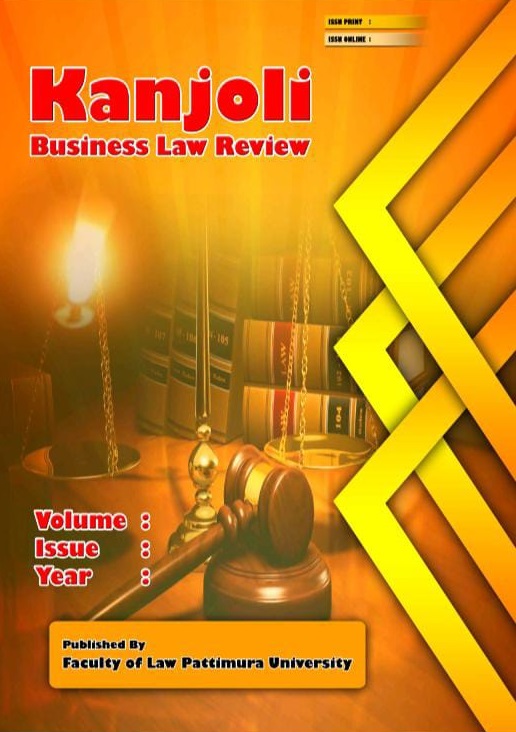Perlindungan Hukum Terhadap Penggunaan Suara Penyanyi dalam Pembuatan Karya Seni Musik Menggunakan Kecerdasan Buatan
Abstract
Currently, there are many musical works of art that are sung by artificial intelligence using the voice of a particular singer. Where, the singer's voice is taken through a music recording and then inputted, studied, and replicated by artificial intelligence. Of course, the taking and use of the singer's voice is done without the permission and rights of the relevant parties. In fact, Law Number 28 of 2014 concerning Copyright has guaranteed the rights of singers as one of the relevant rights holders. The research method used is normative juridical using a statutory approach and conceptual approach. The legal sources used are primary, secondary, and tertiary legal materials with legal material collection techniques using literature study techniques analyzed with qualitative descriptive techniques. The results showed that legal protection of singers whose voices are used in the creation of musical works of art through the use of artificial intelligence technology can be provided in terms of prevention through registration of creations, supervision by the government, and through the procurement of binding legal products. As well as repressive legal protection by blocking and closing content or access rights, filing lawsuits to the Commercial Court, and imposing criminal sanctions.
Downloads
References
Agence France Presse. “Did the AI-Generated Drake Song Breach Copyright?” voanews.com, 2023. https://www.voanews.com/a/did-the-ai-generated-drake-song-breach-copyright-/7061676.html.
Berlianty, Teng, and Yosia Hetharie. “Urgensi Pendaftaran Dan Perlindungan Hukum Terhadap Embal Sebagai Indikasi Geografis Maluku Tenggara.” Jurnal IUS Kajian Hukum Dan Keadilan 8, no. 2 (2020): 244–55.
Hadjon, Philipus M. Perlindungan Hukum Bagi Rakyat Indonesia: Sebuah Studi Tentang Prinsip-Prinsipnya, Penanganannya Oleh Pengadilan Dalam Lingkungan Peradilan Umum Dan Pembentukan Peradilan Administrasi. Surabaya: Peradaban, 2007.
Labetubun, Muchtar A H. “Perlindugan Hukum Desain Industri Di Dunia Maya ( Kajian Overlaping Antara Hak Cipta Dengan Hak Desain Industri ).” SASI 17, no. 4 (2011): 8–19.
Narwadan, Theresia Nolda Agnes. “Hak Moral Pencipta Atas Karya Cipta Yang Diunduh Dari Internet.” SASI 20, no. 2 (2014): 71–79. https://doi.org/10.47268/sasi.v20i2.329.
Pratista, I Gusti Putu Andre, and Ida Ayu Sukihana. “Pelanggaran Hak Moral Karya Lagu/Musik Dan Rekaman Suara Dalam Praktik Penggunaan Hak Cipta.” Kertha Semaya : Journal Ilmu Hukum 2, no. 1 (2014): 1–5.
Sato, Mia, and Richard Lawler. “What’s Really Going on with ‘Ghostwriter’ and the AI Drake Song?” theverge.com, 2023. https://www.theverge.com/2023/4/18/23688141/ai-drake-song-ghostwriter-copyright-umg-the-weeknd.
Copyright (c) 2024 Elsa Amalia Wear, Teng Berlianty, Theresia Nolda Agnes Narwadan (Author)

This work is licensed under a Creative Commons Attribution-NonCommercial 4.0 International License.
Authors who publish their manuscripts in this Journal agree to the following conditions:
- The copyright in each article belongs to the author, as well as the right to patent.
- Authors are able to enter into separate, additional contractual arrangements for the non-exclusive distribution of the journal's published version of the work (e.g., post it to an institutional repository or publish it in a book), with an acknowledgment of its initial publication in this journal.
- Authors are permitted and encouraged to post their work online (e.g., in institutional repositories or on their website) prior to and during the submission process, as it can lead to productive exchanges, as well as earlier and greater citation of published work.
- Authors have the right to self-archiving of the article (Author Self-Archiving Policy)











